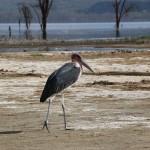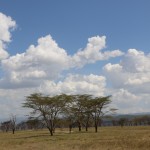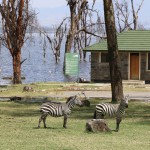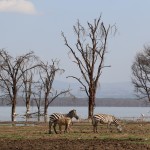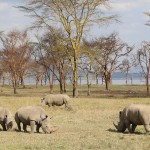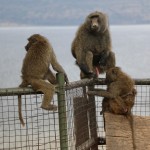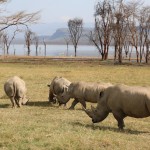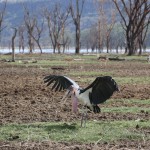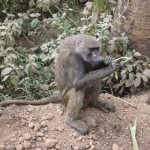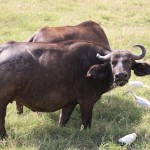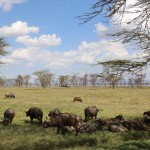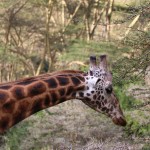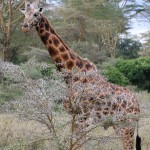Kenya
Very Important Rhinos and Horny Baboons: Lake Nakuru National Park
What do rhinos and presidents have in common in Kenya?
Security.
Yep, that’s right, rhinos in Kenya have the same level of security as the president. And we were on a mission to get up close with these VIR (very important rhinos) in Lake Nakuru National Park.
As one of Kenya’s two Premium Parks Lake Nakuru National Park was originally protected as a bird sanctuary, hosting over 400 bird species, including 5 globally threatened species. It is an important stop on the African-Eurasian Migratory Flyway. This park was also the first national Rhino sanctuary and hosts one of the world’s highest concentrations of the Black Rhinoceros. It is the perfect place to complete (or begin) sighting the big five.
 Unfortunately due to rhinos popularity among the poachers, rhino populations have plummeted and East Africa is doing their best to revive the populations of these magnificent members of the big five. As a rhino sanctuary, Lake Nakuru National Park has been fenced – necessitated to keep out the poachers rather than to restrict the movement of wildlife.
Unfortunately due to rhinos popularity among the poachers, rhino populations have plummeted and East Africa is doing their best to revive the populations of these magnificent members of the big five. As a rhino sanctuary, Lake Nakuru National Park has been fenced – necessitated to keep out the poachers rather than to restrict the movement of wildlife.
Currently Lake Nakuru National Park has 25 black rhinoceros, one of the largest concentrations in the country, plus around 70 white rhinos. Which is really quite incredibly low, given that a baby rhino takes 18 months to incubate.
After two weeks of monkey hunting through Uganda, I was ready for my first African game drive and rhino sighting. As we crossed back into Kenya we headed to Lake Nakuru National Park. Surrounded by rocky escarpments, pockets of forest and at least one waterfall, the park met all of my Lion King expectations (apart from the lack of lions on our visit).
 It did’t take us long to spot the parks resident rhinos. First as specks in the distance, then as
It did’t take us long to spot the parks resident rhinos. First as specks in the distance, then as
roadblocks next to the truck, we got some really incredible views of these big grey creatures.
After our rhino encounter we drove to the bird lair and hopped off the truck to stretch our legs (yes, we got of the truck and walked around the national park that fences in rhinos, lions and leopards). As much as I expected a lion to come bounding towards the group at any second, I did appreciate getting up close with the birdlife (and the few Zebras potting around the area).
Unfortunately due to rising water levels in 2014, the park’s famous flamingoes have mostly fled, but there were a few sticking around, streaking the magnificent lake with pink highlights. Along with some of the more sinister looking local birds, the lake was a party for Lake Nakuru’s birdies.
We hopped back on board the truck and heading up to the peak of the park, where the baboons called home…
 I was well and truly scared of baboons by this point in my trip, so as we made our way to ‘Baboon peak’ the nerves set in. Before we all hopped off the truck to admire the view we were
I was well and truly scared of baboons by this point in my trip, so as we made our way to ‘Baboon peak’ the nerves set in. Before we all hopped off the truck to admire the view we were informed warned that the baboons here ‘liked the ladies’.
Oh god
As we hopped off the bus, the baboons decided to immediately introduce themselves, and exhibit their natural wonders…
Besides some bolder older males, the baby baboons were actually extremely cute and watching them swing and play confidently around us was enchanting.
As we headed home for the day we had one last encounter with a park resident. A poor giraffe barely missed getting hit by our truck, but didn’t seem too concerned. He continued on eating his dinner as we photographed him just as much as a you would photograph a Victoria Secret Model with a wardrobe malfunction.
 Between a few residential rhinos, a group of horny baboons and a photogenic giraffe, Lake Nakuru had definitely given our cameras a run for their money.
Between a few residential rhinos, a group of horny baboons and a photogenic giraffe, Lake Nakuru had definitely given our cameras a run for their money.
Lake Nakuru National Park is an ideal spot for bird watching, hiking, picnic-stopping, game driving, and being sexually harassed by baboons. It is a perfect for animal lovers to get their fix. Because really, what animal counted is complete without at least one of them showing a bit too much love..?
How to get there
- Roads:The park has a tarmac road connection with Nairobi, a distance of 156 km north west of Nairobi on the main A104 road. The most commonly used route into the park is via the main gate, 4 km from Nakuru Town Centre. It is also possible to enter the park from the main Nairobi Nakuru road at Lanet Gate. The Nderit Gate is used by people accessing the park from Masai Mara or Elementaita.
- Airstrips:The Naishi airstrip services the park for tourism and KWS activities.
- Park Roads:The park has an adequate and well serviced motorable roads that make most parts of the park accessible.
- Park Gates:The park has three gates, Main Gate and Lanet Gate that link the park with the Nairobi-Nakuru highway and the less used Nderit Gate.
Park Entry Fee
|
Lake Nakuru National Park |
Citizen |
Resident |
Non – Resident |
|||
|
Adults KSH |
Child KSH |
Adults KSH |
Child KSH |
Adults USD |
Child USD |
|
|
1000 |
200 |
1200 |
600 |
80 |
40 |
|
Phone: 020-2664071, 020-2664079, 020-2671686, 020-2322886, 051-8012070
Mobile: 0728355267, 0728355207, 0728355401
Email: swlakenakuru@kws.go.ke or dicksonr@kws.go.ke







